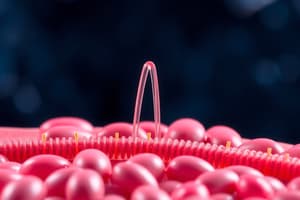Podcast
Questions and Answers
What is the primary role of peripheral proteins in the plasma membrane?
What is the primary role of peripheral proteins in the plasma membrane?
- To be fully embedded in the membrane and facilitate material passage
- To serve as channels for ion transport across the membrane
- To provide structural support and span the membrane
- To be only partially embedded and perform specific functions (correct)
Which statement accurately describes the resting membrane potential in neurons?
Which statement accurately describes the resting membrane potential in neurons?
- The neuron is more permeable to Na+ than to K+ at rest
- The neuron is much more permeable to K+ than to Na+ at resting potential (correct)
- The surrounding environment has an equal concentration of K+ and Na+
- The resting potential is consistent among all cell types
What is one function of membrane proteins in relation to neurotransmitters?
What is one function of membrane proteins in relation to neurotransmitters?
- They induce membrane potential changes without interacting with neurotransmitters.
- They break down neurotransmitters once they are inside the cell.
- They facilitate the diffusion of neurotransmitters directly through the membrane.
- They act as receptors for neurotransmitter chemicals released at synapses. (correct)
What mechanisms are involved in the creation of the membrane potential?
What mechanisms are involved in the creation of the membrane potential?
What structure is utilized to measure the membrane potential in neurons?
What structure is utilized to measure the membrane potential in neurons?
Which ion is primarily pumped out of the cell by the sodium/potassium pump?
Which ion is primarily pumped out of the cell by the sodium/potassium pump?
What major discovery related to action potentials is attributed to Hodgkin and Huxley?
What major discovery related to action potentials is attributed to Hodgkin and Huxley?
What does the fluid-mosaic model describe about the plasma membrane?
What does the fluid-mosaic model describe about the plasma membrane?
Flashcards
Resting Membrane Potential
Resting Membrane Potential
The difference in electrical charge across the plasma membrane of a neuron when it is at rest (not transmitting a signal).
Neuron
Neuron
A specialized cell responsible for receiving, processing, and transmitting information in the nervous system.
Plasma Membrane
Plasma Membrane
The plasma membrane is a thin, flexible barrier that encloses the cell, controlling the passage of substances into and out of the cell.
Ion Channels
Ion Channels
Signup and view all the flashcards
Resting Potential
Resting Potential
Signup and view all the flashcards
Equilibrium Potential
Equilibrium Potential
Signup and view all the flashcards
Sodium/Potassium Pump
Sodium/Potassium Pump
Signup and view all the flashcards
The Spike (Action Potential)
The Spike (Action Potential)
Signup and view all the flashcards
Signup and view all the flashcards
Signup and view all the flashcards
Study Notes
Resting Membrane Potential
- Resting membrane potential is the voltage difference across a neuron's cell membrane when it's not transmitting a signal.
- The inside of a cell is typically negative relative to the outside.
- This difference in charge is crucial for nerve impulse transmission.
Factors Affecting Resting Membrane Potential
- Ion concentrations: Different ion concentrations inside and outside the cell create a concentration gradient. Potassium (K+), sodium (Na+), chloride (Cl-), and anions influence this. Specific concentrations are provided in other sections.
- Membrane permeability: The cell membrane's selective permeability to different ions is critical. The membrane is more permeable to potassium than sodium at rest.
Ion Channels and Their Roles
- Ion channels allow specific ions to pass through the cell membrane. These channels are involved in establishing and maintaining the resting membrane potential.
- The movement of ions down their concentration gradients causes charge separation, leading to the negative inside and positive outside.
The Sodium-Potassium Pump
- The sodium-potassium pump actively transports sodium ions out of the cell and potassium ions back into the cell.
- This mechanism helps maintain the proper ion concentration gradients necessary for resting potential.
- The pump uses energy (ATP) to maintain these gradients.
Membrane Structure and Function
- The plasma membrane surrounds the cell, separating its internal structures from the external environment.
- It controls the passage of materials into and out of the cell, essential for functioning.
- Integral proteins span the membrane, performing various functions.
- Peripheral proteins are partially embedded in the membrane.
The Importance of Resting Potential
- Crucial for nerve impulse transmission; it's the starting point for signal propagation.
- Enables neurons to respond rapidly to stimuli.
Key Figures
- Hodgkin and Huxley: Nobel Prize recipients for their work on action potentials, specifically studied squid giant axons, and their research significantly advanced the understanding of nerve impulses.
Additional Points
- The images presented show diagrams of neurons, plasma membranes, and the process of electrochemical impulse propagation.
- Different regions of the neuron are labeled (dendrites, axon hillock, axon, myelinated/unmyelinated regions).
- Images highlight the roles of neurotransmitters and ion channels in transmitting signals.
- Information includes details on the structure, function, and importance of the plasma membrane.
- Discussion points about resting membrane potential include why osmosis doesn't work in a similar fashion in neurons and the importance of determining resting potential in a neuron, which is a starting point for neuronal signaling.
Studying That Suits You
Use AI to generate personalized quizzes and flashcards to suit your learning preferences.




